Introduction and Package
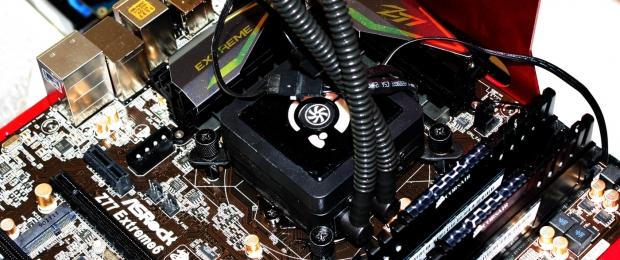
Since February we've been looking at new Intel Z77 Express based motherboards and as the weeks have gone on the pile of Z77 based motherboards has grown larger and larger. It's time to finally start digging into the pile and see just what exactly is going on with them.
While we've looked at the GIGABYTE Z77X-UD5H in some detail when we checked out the Intel Core i7 3570k Ivy Bridge processor, it was not the focus of the article, unlike today where the motherboard is the focus and our benchmark line up will focus on our typical motherboard line up verse the CPU benchmark line up.
The current issue I have with Z77 testing is that it seems so pointless to test on the current crop of Sandy Bridge processors. Z77 boards are designed for the most potent experience with new Ivy Bridge processors. So, we figured that we'd just continue to use our 3770k that we picked up from China last month. When we finally receive our Intel Press Kit with CPUs from Intel we'll be under NDA and we won't be able to make use of our Ivy Bridge processors again till the chips officially launch later this month, but for now we can still run with it.
The first Z77 board we're testing comes from ASRock and is the Z77 Extreme6. It's the first of not only many ASRock Z77 boards we've got to test, but just many Z77 boards period. The first thing we'll do is check out the package to see what exactly ASRock is offering us before moving onto the board itself.
Once we've looked at the board we'll get into the BIOS to see what's going on there before moving onto the overclocking side of things. Once we've done that it's all about the performance we're able to get out of the board.
Package
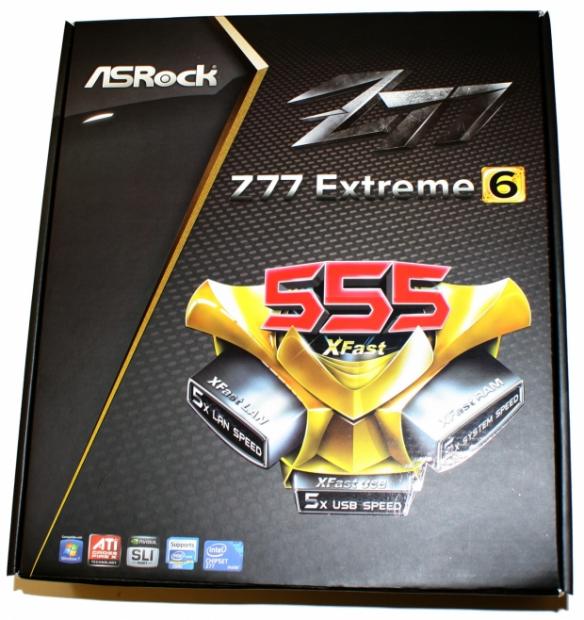


The latest box design from ASRock looks great and you can see they're highlighting the new 555 XFast technology. As for inside we've got the normal driver CD and paperwork along with a few extra pieces explaining the 555 XFast technology and Lucid Virtu MVP.
Lucid Virtu MVP is a technology that is really being pushed by both Lucid and motherboard companies with the launch of the new Ivy Bridge platform. It hasn't got off to the best start in our eyes, though, and if you're interested in learning a bit more about it, I'd highly recommend you check out our Lucid Virtu MVP (HyperFormance) Tested with ASRock Z77 and Intel Ivy Bridge article.


Outside of those bits and pieces we've got four SATA cables, SLI bridge, I/O backplate and a USB 3.0 front panel connector with two USB 3.0 ports on it. This can be also installed in the back of the case via the included bracket in the bundle.
ASRock Z77 Extreme6 Motherboard
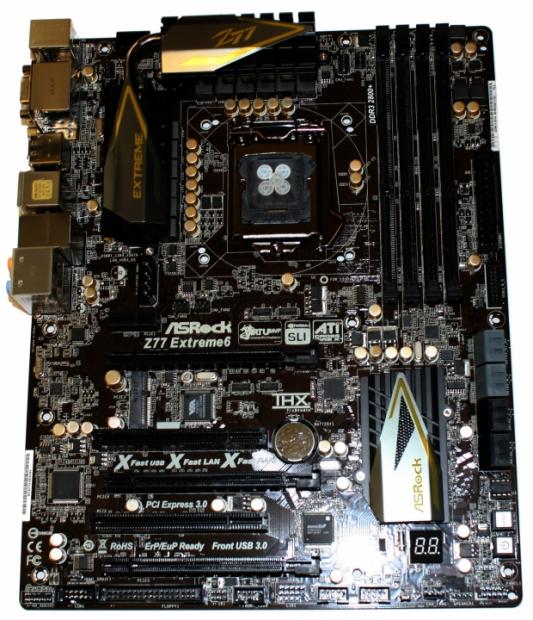
Looking straight on the new ASRock Z77 Extreme6 doesn't look too different to other ASRock boards we've seen lately with the sweet black and gold color scheme, which we really like a lot. Let's move in a little closer, though, to see what exactly we're dealing with here today.
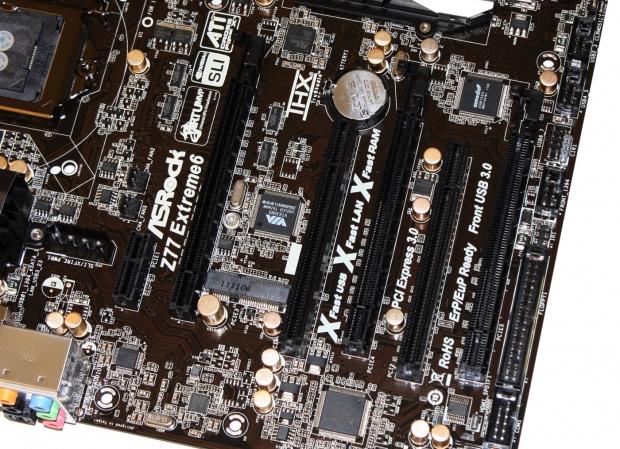
Having a look here we can see on the far left we've got an extra power connector for when you're going to make use of SLI / CrossFire. On the expansion slot front we've got two legacy PCI slots, one PCIe x1 slot and three PCIe x16 slots. Towards the middle we can also see our mSATA slot. While we won't be using it today, it's something we'll be making use of soon.

Moving to the bottom of the board you can see we've got a HD Audio port on the left followed by a COM1 port and surprisingly a floppy connector. Moving across we've got Firewire, two USB 2.0 headers, clear CMOS header, speaker header and our main front panel header.

Turning the corner you can see we've got a power and reset button in the bottom left corner and just behind that you can see the LED debug reader, which helps us diagnose any problems we might run into.
On the SATA front we've got a total of eight ports. We've got four black SATA II ports that run of the Intel controller along with two blue SATA III ports that run off the same controller. Furthermore we've got another two blue SATA III ports which run off the ASMedia ASM1061 controller.
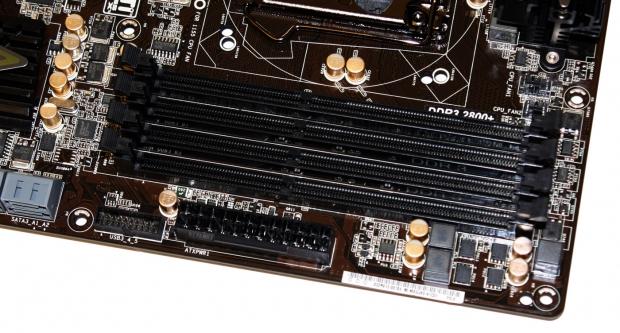
Moving away from the bottom of the board and heading towards the top end we've got the main 24-pin ATX power connector and next to that you can see the USB 3.0 header. We've also got four DDR3 DIMM slots which support memory running at over 2800MHz via overclocking.

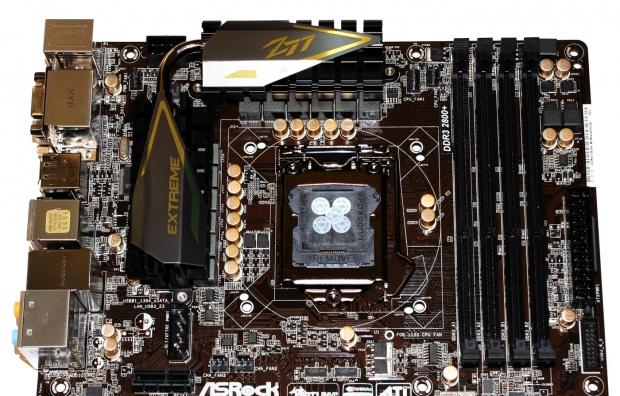
Towards the top of the board you can see the main 8-pin CPU power connector and moving back a little we can see we've got a fairly clean CPU area as we see from most motherboards these days. We can also see a clean heatsink setup around the CPU area.

Moving over to the I/O panel you can see we start off with two USB 3.0 ports that are native to the Z77 Express chipset along with a combo PS2 port. Next to that we've got VGA, DVI, HDMI and DisplayPort for video outs alongside a clear CMOS button.
Moving over again we've got two USB 2.0 ports, FireWire and a combo USB / eSATA port. Gigabit LAN is provided via the Broadcom BCM57781 controller and two more USB 3.0 ports are provided via the Etron EJ168A controller. Finally we finish off with the audio side of things which consist of an optical out and five auxiliary jacks running off the Realtek ALC898 codec.
BIOS










Getting into the BIOS of the Z77 Extreme6 there's nothing we haven't really seen before with the refreshed UEFI interface from ASRock.
If you're heading into the BIOS the chances are that you will spend most the time in the OC Tweaker section where all of the overclocking options are on offer.
Outside of that you can see that everything is fairly self-explanatory from the screenshots above.
Benchmarks - Test System Setup and Overclocking
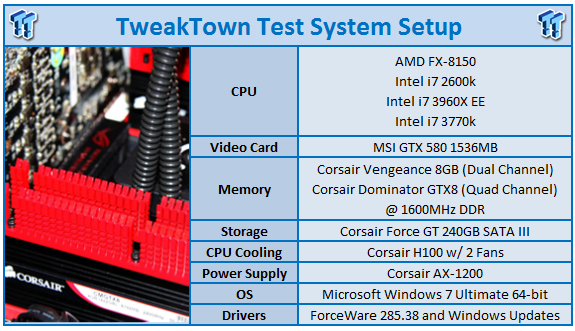
We would like to thank the following companies for supplying and supporting us with our test system hardware and equipment: Intel, ASUS, MSI, Western Digital and Corsair.
Looking above at our testbed you can see there's nothing really out of the ordinary when it comes to the testbed on a whole. The only change from recent motherboard reviews is the inclusion of the Intel i7 3770k Ivy Bridge CPU which you've seen us use before, just not in a motherboard review like this one.
Before we get into the performance side of things the first thing we've got to do is cover the overclocking side of things.
Everything at the moment has pointed to Ivy Bridge overclocking not being that great under water and air cooling conditions due to the higher temperatures that are being seen on the new Intel CPU.
Looking below you can see the 4.72GHz clock we got out of the ASRock Z77 Extreme6 follows that trend compared to clocks of 4.8GHz - 5.2GHz being seen with 2600k Sandy Bridge processors.
It's a nice overclock from the default 3.5GHz clock on offer from the 3770k, but it's not as aggressive as we've seen out of other Intel processors recently. It should still yield a strong performance boost over the stock clocks, so let's see just how the new Z77 Extreme6 performs.

Let's get started!
CPU Benchmarks
HyperPi 0.99
Version and / or Patch Used: 0.99
Developer Homepage: www.virgilioborges.com.br
Product Homepage: www.virgilioborges.com.br
HyperPi is a front end for SuperPi that allows for multiple concurrent instances of SuperPi to be run on each core recognized by the system. It is very dependent on CPU to memory to HDD speed. The faster these components, the faster it is able to figure out the number Pi to the selected length.
For our testing we use the 32M run. This means that each of the four physical and four logical cores for the i7 and the four physical cores of the i5 is trying to calculate the number Pi out to 32 million decimal places. Each "run" is a comparative to ensure accuracy and any stability or performance issues in the loop mentioned above will cause errors in calculation.
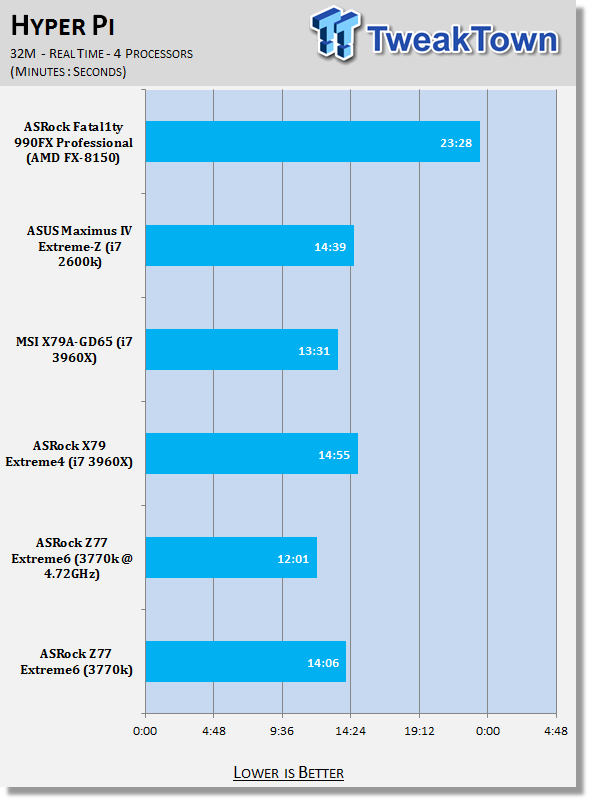
AIDA64
Version and / or Patch Used: 1.00.1035BETA
Developer Homepage: http://www.aida64.com
Product Homepage: http://www.AIDA64.com
Replacing Everest in our labs is AIDA64. This new testing suite is from the core development team from Lavalys and continues that tradition. The guys have thrown in better support for multithreaded CPUs as well as full 64 bit support. We use this to test memory and HDDs for now, but may find ourselves opening this up to other areas of the motherboard.


Starting off with HyperPI we can see that performance on the Z77 Extreme6 with the 3770k is strong compared to the 2600k with a good 30 seconds being shaved off our overall time.
As for AIDA64 performance numbers we're sitting closer to the 3960X than the lower end 2600k. Of course overclocking helps push performance even higher offering some really good numbers.
System Benchmarks
PCMark 7
Version and / or Patch Used: 1.04
Developer Homepage: http://www.pcmark.com
Product Homepage: http://www.pcmark.com
PCMark 7 includes a range of tests that give different views of your system's performance. In the Advanced Edition you can choose which tests to run. The common use and hardware component tests are unavailable in the Basic Edition.
Overall system performance is measured by the PCMark test. This is the only test that returns an official PCMark score. The Lightweight test measures the system capabilities of entry-level systems and mobility platforms unable to run the PCMark test, but it does not generate a PCMark score. Common use performance is measured by the scenario tests - Entertainment, Creativity and Production - each of which results in a scenario score. Hardware component performance is measured by the hardware tests - Computation and Storage - each of which results in a hardware score.

MediaEspresso
Version and / or Patch Used: 6.5
Developer Homepage: http://www.cyberlink.com/
Product Homepage: http://www.cyberlink.com/products/mediaespresso/overview_en_AU.html?fileName=overview&r=1
MediaEspresso is a blazingly fast media universal converter that can transcode your videos, photos and music files and out put them to a huge range of portable devices including mobile phones, portable media players and even game consoles. With technologies like Smart Detect, Direct Sync and CyberLink's TrueTheater™ video enhancements, you can not only forget about complicated format, resolution and output settings, but your converted file will come out the other side looking better than when it went in!

PCMark 7 performance lines up with the Z68 / 2600k combination at stock with no real difference being seen.
As for MediaEspresso performance we can see that our Z77 Extreme6 / 3770k combo comes in a little bit quicker and overclocked it manages to perform over a minute faster than the 3960X when it's running at stock.
USB 2.0 and 3.0 Benchmarks
AIDA64
Version and / or Patch Used: 1.70.1400
Developer Homepage: http://www.aida64.com
Product Homepage: http://www.AIDA64.com
Replacing Everest in our labs is AIDA64. This new testing suite is from the core development team from Lavalys and continues that tradition. The guys have thrown in better support for multithreaded CPUs as well as full 64 bit support. We use this to test memory and HDDs for now, but may find ourselves opening this up to other areas of the motherboard.


Looking at USB performance we can see that USB 2.0 performance is strong thanks to the XFast technology that ASRock implement.
As for USB 3.0 performance which is finally running natively through the Intel chipset, we can see overall performance is similar to other controllers we've looked at in the past.
SSD Benchmarks
AIDA64
Version and / or Patch Used: 1.70.1400
Developer Homepage: http://www.aida64.com
Product Homepage: http://www.AIDA64.com
Replacing Everest in our labs is AIDA64. This new testing suite is from the core development team from Lavalys and continues that tradition. The guys have thrown in better support for multithreaded CPUs as well as full 64 bit support. We use this to test memory and HDDs for now, but may find ourselves opening this up to other areas of the motherboard.
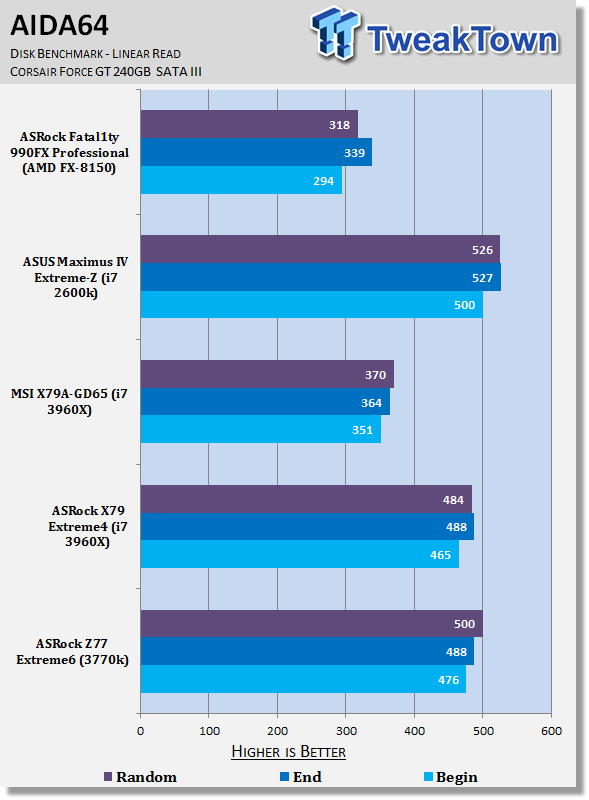
HD Tune Pro
Version and / or Patch Used: 4.61
Developer Homepage: http://www.hdtune.com
Product Homepage: http://www.hdtune.com
HD Tune Pro gives us accurate read, write and access time results and for the last couple of years has been gaining popularity amongst reviewers. It is now considered a must have application for storage device testing.

Looking at SATA III performance we can see that the ASrock Z77 Extreme6 is offering us better performance than the X79 Extreme4. Against the ASUS Maximums IV Extreme-Z, though, we can see it sits just a little behind.
Memory Benchmarks
AIDA64
Version and / or Patch Used: 1.00.1035BETA
Developer Homepage: http://www.aida64.com
Product Homepage: http://www.AIDA64.com
Replacing Everest in our labs is AIDA64. This new testing suite is from the core development team from Lavalys and continues that tradition. The guys have thrown in better support for multithreaded CPUs as well as full 64 bit support. We use this to test memory and HDDs for now, but may find ourselves opening this up to other areas of the motherboard.

Looking at memory performance we can see that the new Z77 / 3770k combo is looking pretty good and doesn't have the same problems that we see out of the X79 platform and it's Quad Channel memory combination, a combination that hasn't shown the strongest performance results.
Gaming Benchmarks
3DMark 11
Version and / or Patch Used: 1.0
Developer Homepage: http://www.futuremark.com
Product Homepage: http://www.3dmark.com/3dmark11/
3DMark 11 is the latest version of the world's most popular benchmark. Designed to measure your PC's gaming performance 3DMark 11 makes extensive use of all the new features in DirectX 11 including tessellation, compute shaders and multi-threading. Trusted by gamers worldwide to give accurate and unbiased results, 3DMark 11 is the best way to consistently and reliably test DirectX 11 under game-like loads.

Metro 2033
Version and / or Patch Used: Latest Steam Update
Timedemo or Level Used: Built in Benchmark
Developer Homepage: http://www.4a-games.com//
Product Homepage: http://www.thqnordic.com/
Metro 2033 is an action-oriented video game with a combination of survival horror and first-person shooter elements. The game is based on the novel Metro 2033 by Russian author Dmitry Glukhovsky. It was developed by 4A Games in Ukraine and released in March 2010 for Microsoft Windows and Xbox 360.[3] In March 2006, 4A Games announced a partnership with Glukhovsky to collaborate on the game.[4] The game was announced at the 2009 Games Convention in Leipzig;[5] a first trailer came along with the announcement.[6] A sequel was announced, currently titled Metro: Last Light.

Under 3DMark 11 we can see that all our Intel based setups sit pretty close to each other with the only real change being seen in the Performance preset when overclocked.
Under Metro 2033, though, we can see that at 1920 x 1200 and 1680 x 1050, the Z77 Extreme6 comes out ahead of the other setups.
Temperature and Power
Power Consumption

Power draw is a real highlight on the new Ivy Bridge platform and you can see here the power draw numbers are impressive at both stock and overclocked settings.
Core Temperature

Heat, on the other hand, isn't something that the new Ivy Bridge is dealing well with.
We can see that temperatures are higher than our other platforms at both idle and load and you can see load temperatures really sky rocket when overclocked.
This isn't bad contact or anything either, we've seen this out of multiple Ivy Bridge based processors on multiple boards. Talking to partners as well, we see the results are consistent.
Final Thoughts
The new Ivy Bridge platform from Intel is a bit of an interesting one and we've almost got this AMD Bulldozer like aura hanging over it. There are two things that feel similar to the Bulldozer launch. The first is that Intel has split the release of the motherboard chipset and accompanying CPUs. Something that makes no sense at all, especially considering we've been seeing Ivy Bridge CPUs for weeks now.
The second is the huge clocks we've seen out of the processors via LN2 which doesn't translate to air and water cooled processors. Bulldozer saw these awesome high clocks on LN2 and other high-end cooling solutions, but when it came to your typical kind of cooling solution (air), the numbers couldn't be reached at all.
The current crop of Ivy Bridge chips are similar. Talking to people who do use LN2, the new platform absolutely loves being cooled by it, more so than other Intel chips. On more conventional cooling, though, we see that the Ivy Bridge chip runs fairly warm with 100c not being uncommon with standard air cooling solutions.
As for the motherboard itself, ASRock in typical fashion have put together a really nice offering that performs well, looks great and comes in at a really strong price point. At $174.99 the ASRock Z77 Extreme6 looks like a great buy for anyone interested in jumping on the Z77 bandwagon.
The main thing you've got to decide now is if you grab yourself a Z77 based motherboard now and pair it with a Sandy Bridge CPU like the 2700k or wait a few more weeks for the official launch of the new Ivy Bridge CPUs and buy a board and CPU then.
There's really no wrong answer; if you're looking for a good performing Z77 motherboard that comes with a nice little bundle and hits at a strong price point then the new ASRock Z77 Extreme6 is a board that you should be looking at.

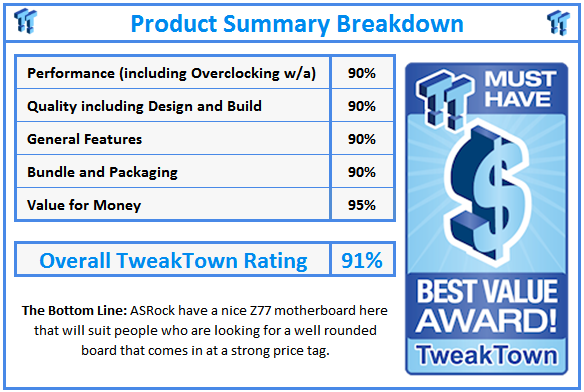
 United
States: Find other tech and computer products like this
over at
United
States: Find other tech and computer products like this
over at  United
Kingdom: Find other tech and computer products like this
over at
United
Kingdom: Find other tech and computer products like this
over at  Australia:
Find other tech and computer products like this over at
Australia:
Find other tech and computer products like this over at  Canada:
Find other tech and computer products like this over at
Canada:
Find other tech and computer products like this over at  Deutschland:
Finde andere Technik- und Computerprodukte wie dieses auf
Deutschland:
Finde andere Technik- und Computerprodukte wie dieses auf